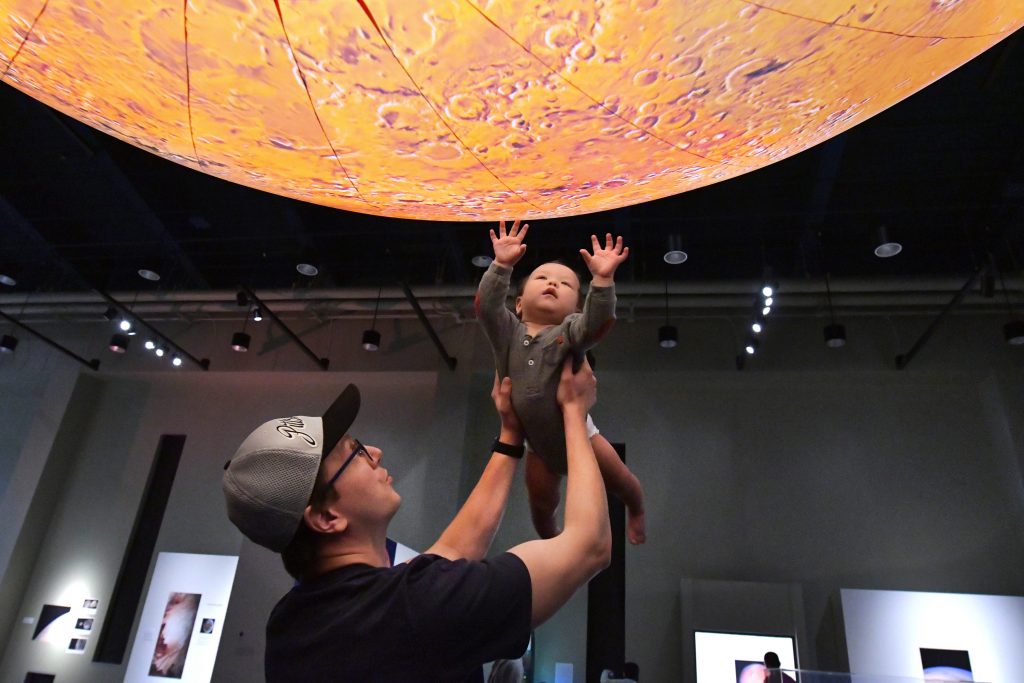Peoria Riverfront Museum planetarium director Renae Kerrigan has long had her eyes on the sky.
Renae Kerrigan never gets tired of looking up.
As planetarium director at Peoria Riverfront Museum, she’s not only busy planning daily planetarium shows with her staff but regularly pointing out celestial events through emails and YouTube videos, where she has earned quite the following. That was especially true during the pandemic, when she helped take an otherwise closed museum virtual, attracting an impressive 88,000 worldwide viewers to her Facebook live event on the great conjunction of Saturn and Jupiter.
But Kerrigan, 33 and a recent 40 Under Forty selection for her work as a “nationally respected evangelist for science, astronomy and the environment,” isn’t one to rest on her laurels. Indeed, she tasked herself with another duty in 2022: Come up with a museum exhibit on Mars.
After pitching the idea to museum CEO John Morris and Curator Bill Conger last spring, Kerrigan got the green light this fall, with the show starting on Oct. 7 and running through Spring 2023. That wasn’t much time to showcase an entire planet, especially one as fabled as Mars.

After all, from H.G. Wells’ War of the Worlds in 1898 and Orson Welles’ radio version of the same in 1938 to the work of science fiction writers such as Ray Bradbury and Robert Heinlein, Mars has always been that other world we Earthlings viewed with a combination of fear, suspicion and wonder.
While we’ve yet to spot any sign of invaders, we have learned that, in the words of National Geographic, “until 3.5 billion years ago, the dry, toxic planet we see today might have once been as habitable as Earth.”
It doesn’t matter that Mars and Earth are 50 million miles apart. The red planet has never seemed closer, with three robots roving about the Martian surface as we speak, two from the United States and one from China. The photos and other data they send back continue to add to our body of knowledge on the planet.
“There are lots of exciting things happening,” said Kerrigan, referring to the steady stream of media stories involving Mars—from news about the Perseverance rover collecting rock samples to aerial video taken by Ingenuity, the little Mars helicopter launched from Perseverance. Then there’s the recent New York Times report that researchers have been remotely scouting Mars to identify subterranean caves that might serve as suitable shelter for future residents.
“It would be challenging to live on Mars. People would have to live under shelter,” said Kerrigan, citing frigidly cold temperatures and an atmosphere so thin that it would fail to shield humans from radiation.
But humans have dreamed of visiting Mars since the 1700s. “Humans are explorers,” Kerrigan said. “We always want to chart new waters.”
Kerrigan believes there’s pent-up demand when it comes to space exploration, recalling that the Apollo program was curtailed after Apollo 17, the flight that featured the last moon walk in 1972. “There were supposed to be other flights up to Apollo 20 but those missions were canceled,” she said.
“I love the robotic exploration we’ve done. Without it, we wouldn’t know much about the outer planets,” added Kerrigan, referring to the Voyager space probes that were launched in the ‘70s. “But why not both? I think there’s also great value in human exploration,” she said, adding that human involvement also attracts public interest.
To build a display on Mars, Kerrigan had to find enough objects for an exhibition. Among the items she came up with are full-size models (on loan from NASA’s Jet Propulsion Laboratory) of the first robotic rovers to explore a planet that’s about half the size of Earth.
“There’s the rover called Opportunity that landed on Mars in 2004. It was only supposed to last 90 days but wound up running for 14 years. They thought the battery would die but Martian winds blew the dust off the solar panels,” she said.
In the selection of images used in the show, Kerrigan perused hundreds of pictures. She also had to find a way to involve interactivity, those hands-on displays that museums have learned occupy young minds. That’s why you’ll find an augmented reality sandbox in the museum’s Mars exhibit with a topographic map of Mars.
The planet is on full display. A centerpiece of the exhibit is the 10-foot illuminated spherical sculpture made by British artist Luke Jerram, whose handiwork has been displayed at the museum before, in the form of the Moon sphere. The Mars artwork was sponsored by Sheldon Schafer, the planetarium’s director who retired in 2013.
“He taught me how to work in a museum,” said Kerrigan, who also included a display on fictional works involving the planet such as “Mars Attacks,” the Tim Burton movie, and those of Edgar Rice Burroughs, the creator of Tarzan who also wrote 10 books featuring John Carter of Mars. Kerrigan credits a museum team that includes Zac Zetterberg and Ben Panfil for helping set up the Martian exhibit.
Ultimately, Kerrigan is a believer when it comes to colonizing Mars. She echoes the words of SpaceX founder (and Twitter owner) Elon Musk: “It’s important for the survival of the species to have humanity on two planets.”





